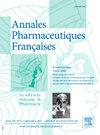用于癌症靶向治疗的palbociclib负载PLGA纳米气泡的开发与表征。
IF 1.1
Q4 PHARMACOLOGY & PHARMACY
引用次数: 0
摘要
研究目的本研究旨在开发和优化用于乳腺癌靶向治疗的palbociclib负载纳米气泡:使用生物相容性聚(DL-内酯-共聚乙二醇)制造出装载palbociclib的纳米气泡。制剂过程采用三级盒式贝肯设计和双乳液溶剂蒸发法精心制作,以精确定制纳米气泡的特性:德林格尔可取性方法通过将反应转化为可取性量表来优化变量,从而得出一个总体可取性值。最佳设置为:A:526.97 毫克;B:250 毫克;C:2.0% w/v;D:6101 转/分,D 值为 0.949。Palbociclib 纳米气泡的粒径(31.78±2.12)小于普通纳米气泡(38.56±3.56)。PDI 值表明粒度分布均匀。zeta电位保持一致,普通纳米气泡为-31.34±3.36,药物负载纳米气泡为-31.56±3.12。包囊效率为 70.12%,表明药物包囊效果显著。Palbociclib 在 pH 值为 7.4 的纳米气泡中的释放率明显更高,尤其是在超声波作用下,药物释放率接近 99.34%。溶血活性测定证实了注射的安全性。荧光强度分析表明,超声波可使细胞对帕博昔单抗的吸收增加两倍。MTT 试验表明,特别是在使用超声波的情况下,palbociclib 负载纳米气泡的细胞毒性增强,这凸显了纳米气泡提高疗效的潜力。在不使用超声波和使用超声波的情况下,palbociclib的IC50值分别为98.3μM、72.34μM和61.34μM:本研究的重要发现强调了palbociclib负载纳米气泡作为一种治疗系统在改善乳腺癌治疗方面的潜力。本文章由计算机程序翻译,如有差异,请以英文原文为准。
Development and characterization of palbociclib-loaded PLGA nanobubbles for targeted cancer therapy
Objective
The objective of this study was to develop and optimize palbociclib-loaded nanobubbles for targeted breast cancer therapy.
Materials and methods
Biocompatible poly(DL-lactide-co-glycolide) was used to create nanobubbles loaded with palbociclib. The formulation process was meticulously crafted using a three-level Box-Behnken design and a double emulsion solvent evaporation method to precisely tailor the nanobubbles’ properties.
Results
The Derringer's desirability method optimized variables by transforming responses into a desirability scale, resulting in a global desirability value. Optimal settings, A: 526.97 mg, B: 250 mg, C: 2.0% w/v, D: 6101 rpm, achieved a D value of 0.949. Palbociclib nanobubbles demonstrated a smaller particle size (31.78 ± 2.12) than plain nanobubbles (38.56 ± 3.56). PDI values indicated a uniform size distribution. The zeta potential remained consistent, with values of −31.34 ± 3.36 for plain and −31.56 ± 3.12 for drug-loaded nanobubbles. Encapsulation efficiency was 70.12%, highlighting effective drug encapsulation. Palbociclib release was significantly higher from nanobubbles in pH 7.4, especially with ultrasound, releasing almost 99.34% of the drug. Hemolytic activity assays confirmed safety for injection. Fluorescent intensity analysis revealed a two-fold increase in cellular uptake of palbociclib facilitated by ultrasound. The MTT assay demonstrated enhanced cytotoxicity of palbociclib-loaded nanobubbles, especially with ultrasound, emphasizing their potential for improved therapeutic efficacy. The IC50 values for palbociclib, without ultrasound, and with ultrasound were 98.3 μM, 72.34 μM, and 61.34 μM, respectively.
Conclusion
The significant findings of this study emphasize the potential of palbociclib-loaded nanobubbles as a promising therapeutic system for improved breast cancer treatment.
Objectif
L’objectif de cette étude était de développer et d’optimiser la formulation de nanobulles chargées en palbociclib comme thérapie ciblée du cancer du sein.
Matériel et méthodes
Un copolymère poly(acide lactique-co-glycolique) [PLAGA] biocompatible a été utilisé pour créer des nanobulles chargées en palbociclib. Le processus de formulation a été méticuleusement conçu en utilisant un plan d’expérience de Box-Behnken à trois niveaux et une méthode par double émulsion évaporation de solvant a pu être optimisée pour ajuster précisément les propriétés des nanobulles.
Résultats
La méthode de désirabilité de Derringer a permis d’optimiser les variables en transformant les réponses en une échelle de désirabilité, ce qui a abouti à une valeur de désirabilité globale (D). Les paramètres optimaux, A : 526,97 mg de palbociclib, B : 250 mg de PLAGA, C : 2,0 % p/v de PVA, D : 6101 tr/min, ont atteint une valeur D de 0,949. Les nanobulles de palbociclib ont montré une taille de particule plus petite (31,78 ± 2,12 nm) que les nanobulles classiques (38,56 ± 3,56 nm). Les valeurs de l’indice de polydispersité indiquaient une distribution de taille uniforme. Le potentiel zêta est resté constant, avec des valeurs de −31,34 ± 3,36 pour les nanobulles classiques et de −31,56 ± 3,12 pour les nanobulles chargées en médicament. L’efficacité d’encapsulation était de 70,12 %, mettant en évidence une encapsulation efficace du médicament. La libération de palbociclib était significativement plus élevée à partir des nanobulles à pH 7,4, surtout lorsqu’elles étaient soumises aux ultrasons, libérant près de 99,34 % du médicament. Les essais d’activité hémolytique ont confirmé la sécurité pour l’injection. L’analyse de l’intensité fluorescente a révélé un doublement de l’absorption cellulaire du palbociclib facilitée par les ultrasons. L’essai MTT a montré une cytotoxicité accrue des nanobulles chargées en palbociclib, surtout avec les ultrasons, soulignant leur potentiel pour une efficacité thérapeutique améliorée. Les valeurs d’IC50 pour le palbociclib, sans ultrason, et avec ultrasons entaient respectivement de 98,3 μM, 72,34 μM et 61,34 μM respectivement.
Conclusion
Les résultats significatifs de cette étude mettent en évidence le potentiel des nanobulles chargées en palbociclib comme un système thérapeutique prometteur pour améliorer le traitement du cancer du sein.
求助全文
通过发布文献求助,成功后即可免费获取论文全文。
去求助
来源期刊

Annales pharmaceutiques francaises
PHARMACOLOGY & PHARMACY-
CiteScore
1.70
自引率
7.70%
发文量
98
期刊介绍:
This journal proposes a scientific information validated and indexed to be informed about the last research works in all the domains interesting the pharmacy. The original works, general reviews, the focusing, the brief notes, subjected by the best academics and the professionals, propose a synthetic approach of the last progress accomplished in the concerned sectors. The thematic Sessions and the – life of the Academy – resume the communications which, presented in front of the national Academy of pharmacy, are in the heart of the current events.
 求助内容:
求助内容: 应助结果提醒方式:
应助结果提醒方式:


